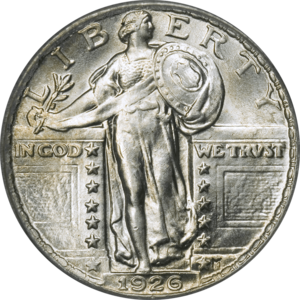Washington quarter facts for kids
| United States | |
| Value | 25 cents (0.25 US dollars) |
|---|---|
| Mass | 5.67 g |
| Diameter | 24.3 mm |
| Edge | reeded |
| Orientation | coin (180°) |
| Composition | Current—cupronickel clad to copper. Prior to 1965—6.25 grams, 90% silver, 10% copper. Silver versions for collectors since 1976 also exist |
| Years of minting | 1932, 1934–present |
| Mint marks | D, S, P, W. Mintmark location & history on 1932–2021 coins discussed in #Clad composition. |
| Obverse | |
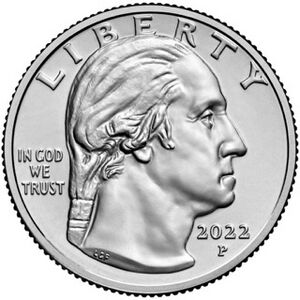 |
|
| Design | Bust of George Washington. Variants of previous obverse shown in #Silver quarter production. |
| Designer | Laura Gardin Fraser |
| Design date | 1931 |
| Reverse | |
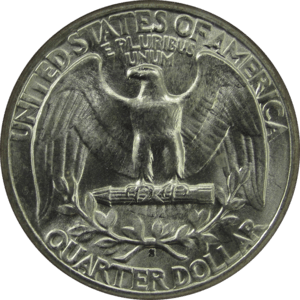 |
|
| Design | Eagle |
| Designer | John Flanagan |
| Design date | 1931 |
| Design | Washington crossing the Delaware River in 1776 |
| Designer | Benjamin Sowards, sculpted by Michael Gaudioso |
| Design date | 2020 |
| Design | Various commemorative designs |
| Designer | Various |
The Washington quarter is a 25-cent coin made by the United States Mint. It was first made in 1932. The first design was created by a sculptor named John Flanagan.
In 1932, the United States wanted to celebrate the 200th birthday of its first president, George Washington. A special committee wanted to put Washington's picture on the half dollar coin. Instead, Congress decided to replace the old Standing Liberty quarter with a new quarter featuring Washington.
The committee wanted sculptor Laura Gardin Fraser to design the new coin. Her design was supported by the Commission of Fine Arts. However, the Treasury Secretary, Andrew W. Mellon, chose Flanagan's design instead. The new silver quarters started being used on August 1, 1932.
These coins were made of silver until 1965. After that, they were made of a mix of copper and nickel. In 1975 and 1976, a special design was used to celebrate the United States Bicentennial (200 years of the USA). These coins had the dates "1776–1976" on them. There are no quarters dated 1975.
Since 1999, the original eagle design on the back of the coin has not been used. Instead, the back of the quarter has shown designs honoring the 50 states, other U.S. areas, and famous natural sites. This continued until 2021 with the America the Beautiful Quarters series.
In 2021, Flanagan's original design of Washington returned to the front of the coin. The back showed Washington crossing the Delaware River. In 2022, a new series began, featuring important American women.
Contents
Original Quarter Design (1932–1998)
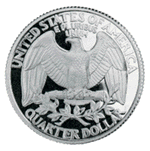
The first Washington quarter design, used until 1998, showed a picture of George Washington facing left. Above his head was "Liberty," and below was the date. To the left, it said "In God We Trust." The back of the coin showed an eagle with its wings spread out, sitting on a bundle of arrows. This was surrounded by two olive branches.
These coins were first made of 90% silver. In 1964, they changed to a mix of 75% copper and 25% nickel, with a pure copper center. Special silver versions have also been made for collectors since 1976.
How the Quarter Was Created
In 1924, Congress started planning for George Washington's 200th birthday in 1932. They wanted to create a special coin to celebrate. At first, they thought about a Washington half dollar. They wanted this coin to replace the regular half dollar for just one year.
However, in 1931, Congress decided to create a Washington quarter instead. This new quarter would permanently replace the old Standing Liberty quarter. This was because the old quarter was difficult to make. The new quarter would honor Washington and make coin production easier for the Mint.
The law said that Washington's image on the front of the coin should be based on a famous sculpture of him by a French artist named Jean-Antoine Houdon.
Choosing the Design
The Bicentennial Committee and the Commission of Fine Arts both liked designs by Laura Gardin Fraser. She was a well-known coin designer. They wanted her designs for the new quarter.
However, the Treasury Department decided to hold its own design competition. Even though the Fine Arts Commission still chose Fraser's designs, Treasury Secretary Andrew W. Mellon picked a design by John Flanagan.
The Fine Arts Commission tried to get Mellon to change his mind, but he didn't. When a new Treasury Secretary, Ogden L. Mills, took over, the commission tried again. But Mills also decided to stick with Flanagan's design. The public learned about Flanagan's design being chosen on April 16, 1932.
Washington's Portrait on the Coin
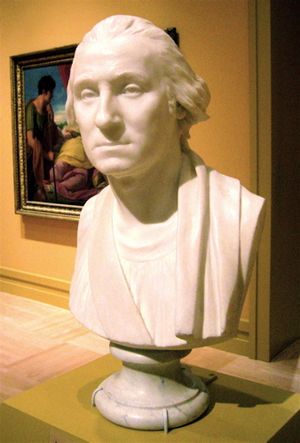
The image of Washington on the quarter comes from a sculpture made in 1785 by a French artist, Jean-Antoine Houdon. Houdon visited Washington at his home, Mount Vernon, to create a life mask of his face. This mask helped Houdon make a very realistic sculpture.
Houdon's sculpture of Washington became very famous. Many later portraits of Washington on coins and medals were based on Houdon's work. Flanagan's design for the quarter was inspired by this famous sculpture.
Silver Quarter Production
The Washington quarter was first released on August 1, 1932. About 6.2 million quarters were made that year. Most of them were made at the Philadelphia mint. The Denver and San Francisco mints made fewer. The 1932 Denver and San Francisco quarters are quite rare today. No quarters were made in 1933 because there were already enough from 1932.
The Washington quarter was well-made and showed all its details clearly. The Mint made small changes to the design over the years. For example, in 1944, Flanagan's initials on Washington's bust became distorted, so they were fixed the next year. Silver quarters continued to be made until 1964.
Quarters with New Metal (Clad Coins)
In 1964, there was a big shortage of coins. The price of silver was going up, so people started collecting silver coins instead of spending them. To fix this, President Lyndon Johnson announced in 1965 that dimes and quarters would no longer be made of silver.
Instead, they would be made of a "clad" material. This meant they had layers: an outer layer of copper-nickel and an inner core of pure copper. This change happened in 1965.
The new clad quarters were made without a mint mark (a small letter showing where the coin was made) from 1965 to 1967. Starting in 1968, mint marks were used again, except for coins made in Philadelphia. The San Francisco Mint started making quarters again, but mostly for collectors. The mint marks on quarters made after 1967 are found on the front, to the right of Washington's neck.
In 1980, the Philadelphia Mint started using the "P" mint mark on its coins. Since 1992, the Mint has also sold special silver proof sets for collectors, which include quarters made of 90% silver.
Bicentennial Quarters (1975–1976)
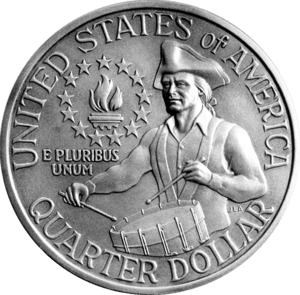
In 1973, Congress decided to create special designs for the quarter, half dollar, and dollar to celebrate the United States Bicentennial (200 years of the USA). These coins were made from July 4, 1975, to January 1, 1977. They all had the double date "1776–1976." This means there are no quarters dated 1975.
The Bicentennial quarter featured a colonial drummer design by Jack L. Ahr on the back. The Mint made almost two billion of these quarters to make sure everyone could get one as a souvenir. After 1976, Flanagan's original eagle design returned to the back of the quarter.
Washington Quarters Since 1999
50 State Quarters

In 1997, Congress passed a law to create the 50 States Commemorative Coin Program. This program honored each of the fifty states with a new quarter design. Five new state quarters were released each year, starting in 1999. The order of release was based on when each state joined the United States.
To make room for the large state designs on the back, some words like "UNITED STATES OF AMERICA" and "QUARTER DOLLAR" were moved to the front of the coin. Washington's portrait was also made a little smaller. Each state's design was chosen by the Treasury Secretary, usually based on ideas from the state's governor.
The Mint also sold special collector's versions, including ones made of 90% silver. This program was very popular and helped many people start collecting coins.
District of Columbia and U.S. Territories Quarters
After the 50 State Quarters program ended, Congress decided to extend it. In 2007, a law was passed to honor the District of Columbia and the U.S. territories.
In 2009, quarters were made with designs honoring the District of Columbia, Puerto Rico, Guam, American Samoa, the Virgin Islands, and the Northern Mariana Islands. The front of these coins still had the Washington portrait.
America the Beautiful Quarters
In 2008, Congress passed another law for a new series of quarters called "America's Beautiful National Parks Quarter Dollar Coin Act." This series featured 56 different designs, one for each state or territory. Each coin showed a National Park Service site or national forest.
These coins were released five per year, starting in 2010 and ending in 2021. Flanagan's original head of Washington was brought back to the front of the coin, with more detail. Besides regular coins, special silver bullion coins were also made with these designs.
In 2019, the Mint started making some regular quarters at the West Point Mint with a "W" mint mark. These were mixed in with coins from Philadelphia and Denver. This continued in 2020, with the 2020-W quarters having a small "V75" mark on the front.
2021: Return of the Original Front Design
After the National Parks quarter series finished in 2021, the quarter's design changed again. The front of the coin went back to Flanagan's original design of Washington. The back featured a new image of George Washington's crossing of the Delaware River on Christmas night, 1776. This quarter was released on April 5, 2021, and was made until the end of that year.
New Quarter Series (2022–2030)
A new law, the Circulating Collectible Coin Redesign Act of 2020, created three new series of quarters for the next decade.
- From 2022 to 2025, the Mint is making up to five coins each year featuring important American women. These coins have a new design of Washington on the front.
- In 2026, there will be special designs to celebrate the 250th anniversary of the United States (the United States Semiquincentennial).
- From 2027 to 2030, the Mint will make up to five coins each year featuring youth sports. The front of the coin will also be redesigned in 2027, but it will still show Washington.
American Women Quarters
The American Women quarters program started in 2022 and will continue until 2025. Each year, up to five new designs are released on the back of the coin. These designs honor the achievements and contributions of women throughout American history. The front of these coins features Laura Gardin Fraser's portrait of Washington, which was originally planned for the first Washington quarter in 1932.
See also
- Washington quarter mintage figures


